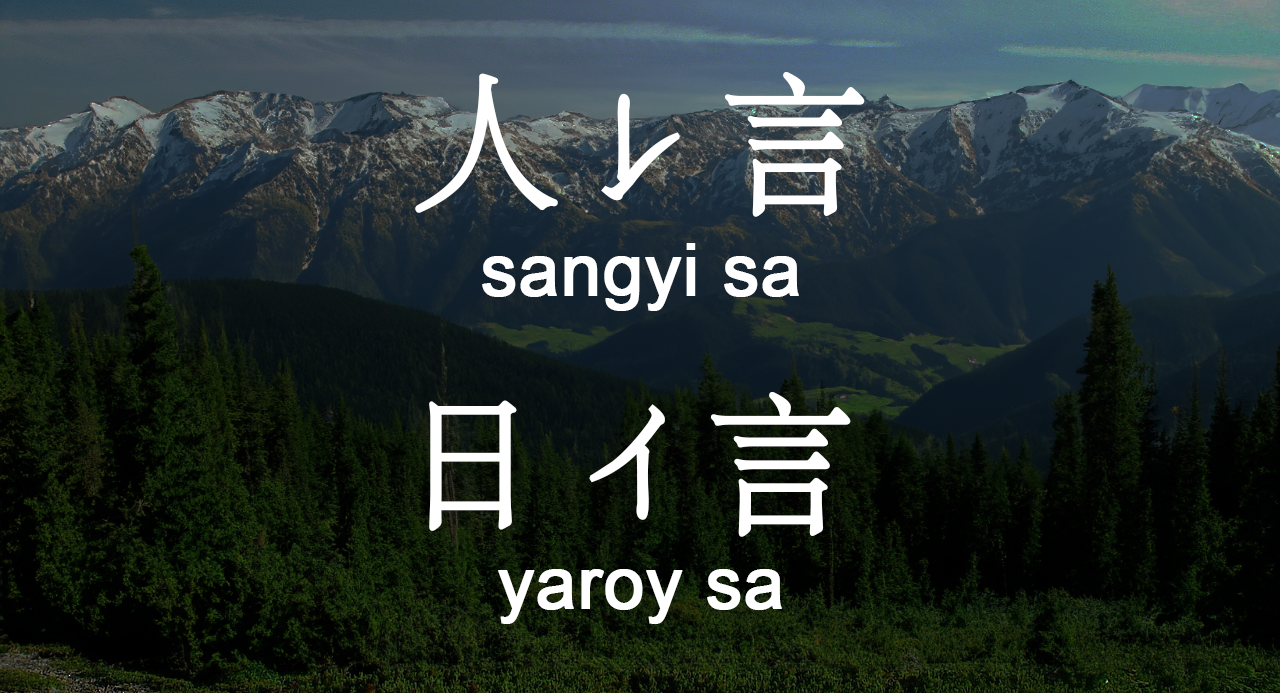Sangui [SNGI]
▲
2▲ 2 ▼ 0
Registered by
[Deactivated User] on 12 April 2024
Language type
A priori
Place & SpeakersSangui is spoken in Borealia.
Species
Human/humanoid
About Sangui
Sangui (人𛄠言, sangyi sa, [səŋ'gʲi sa], literally "human language") or Yaroy (日イ言, yaroy sa, [ji'ɣoj sa], "language of the sun") is an isolate language spoken by the Yaroy ethnic group on the northern part of the Boreal Island, located in the North Pacific Ocean near Japan. Their language has various influences in its vocabulary, such as from Japanese and French. Most Yaroys are bilingual, they speak their native language and French.
Prior to the colonisation of the island by Europeans, the Yaroys lived a sedentary lifestyle in villages and small towns. They maintained relations with their southern neighbours, the Aylun tribes, who spoke an Austronesian language close to Marshallese, as well as with other peoples, such as the Japanese. The southern part of the Boreal Island was colonised by the Dutch in the early 17th century, but the territory was conquered by France in 1677 during the Franco-Dutch War. In the 18th century, France began to explore the northern part of the island, making first contact with various Yaroy tribes and kingdoms. In 1792, during the French Revolution, Borealia declared its independence. After the establishment of the republic on the island, there were many small conflicts between Europeans and the Yaroy tribes, which eventually led to the signing of the Treaty of Taytay between Borealia and Manyi, the strongest Yaroy dynasty on the island. As a result, most of the territories became protectorates of Borealia and, at the end of the 19th century, were completely annexed (with the exception of the city of Kyochi, which was captured by Japan). During World War II, Japan attacked Borealia and seized some Yaroy territories, but they were later recaptured with American support. In 1946, the Borealian Civil War broke out, leading to the establishment of a new government that gave the Yaroys autonomy. Sangui became the co-official language of the country.

Prior to the colonisation of the island by Europeans, the Yaroys lived a sedentary lifestyle in villages and small towns. They maintained relations with their southern neighbours, the Aylun tribes, who spoke an Austronesian language close to Marshallese, as well as with other peoples, such as the Japanese. The southern part of the Boreal Island was colonised by the Dutch in the early 17th century, but the territory was conquered by France in 1677 during the Franco-Dutch War. In the 18th century, France began to explore the northern part of the island, making first contact with various Yaroy tribes and kingdoms. In 1792, during the French Revolution, Borealia declared its independence. After the establishment of the republic on the island, there were many small conflicts between Europeans and the Yaroy tribes, which eventually led to the signing of the Treaty of Taytay between Borealia and Manyi, the strongest Yaroy dynasty on the island. As a result, most of the territories became protectorates of Borealia and, at the end of the 19th century, were completely annexed (with the exception of the city of Kyochi, which was captured by Japan). During World War II, Japan attacked Borealia and seized some Yaroy territories, but they were later recaptured with American support. In 1946, the Borealian Civil War broke out, leading to the establishment of a new government that gave the Yaroys autonomy. Sangui became the co-official language of the country.

Sample of Sangui[view] A las yol malas. Syot ahan siwo. / 訊在或不在。這問ヌ是ヲ。
To be, or not to be? That is the question.[view all texts]
To be, or not to be? That is the question.[view all texts]
Language family relationships
[view] About IsolatesThis is a family for isolate languages.
Phonology
| Consonants | Bilabial | Labio- dental | Alveolar | Retroflex | Palatal | Labio- velar | Velar | Glottal | Other | |||||||||
| Nasal | m | n | ŋ | |||||||||||||||
| Plosive | p | b | t | d | k | g | ||||||||||||
| Fricative | f | v | s | z | ʂ | ʐ | ɣ | h | ɦ | |||||||||
| Affricate | t͡s | d͡z | ʈ͡ʂ | ɖ͡ʐ | ||||||||||||||
| Lateral approximant | l | ɫ | ||||||||||||||||
| Approximant | j | w | ||||||||||||||||
| Vowels | Front | Central | Near- back | Back | ||||
| Close | i ʲi ʲi: | ɨ ɨ: | ʲu ʲu: | |||||
| Near-close | ʊ ʊ: | |||||||
| Close-mid | ʲe ʲe: | o ʲo ʲo: o: | ||||||
| Mid | ə ə: | |||||||
| Open-mid | ɛ ɛ: | ɞ ɞ: | ||||||
| Open | a ʲa ʲa: a: | |||||||
Orthography
Below is the orthography for Sangui. This includes all graphemes as defined in the language's phonology settings - excluding the non-distinct graphemes/polygraphs.
 SanguiOrthography [edit] SanguiOrthography [edit] | ||||||||||
| Aa/ə/, /a/ | Bb/b/ | Dd/t/, /d/ | Ee/ɛ/, /ə/ | Ff/f/ | Gg/k/, /g/ | Hh/h/, /ɦ/ | Ii/ɨ/, /ɞ/ | Jj/ʐ/, /ʂ/ | Kk/k/ | Ll/ɫ/ |
| Mm/m/ | Nn/n/ | Oo/ʊ/, /o/ | Pp/p/ | Rr/ɣ/ | Ss/s/ | Tt/t/ | Vv/v/, /f/ | Ww/w/ | Yy/j/ | Zz/z/, /s/ |
| ✔ Shown in correct order [change] | ||||||||||







